Panmunjom: Senior US and South Korean military officials pledge stronger operational capabilities against North Korea’s provocations.
Key Point 1: Senior US and South Korean military officials visited Panmunjom to showcase solidarity.
Key Point 2: They pledged to enhance operational capabilities to counter provocations from North Korea.
Key Point 3: Joint air drills involving US B-1B bombers were conducted over the Korean Peninsula.
Key Point 4: Rising tensions include dramatic actions such as North Korea destroying border infrastructure.

United Front Against North Korea: Key Developments in Panmunjom
A Historic Show of Unity
In a significant display of military alliance, top officials from the United States and South Korea visited the village of Panmunjom, the symbolic site of the Korean Armistice Agreement, on Friday. The visit emphasized their joint efforts to counter provocations from North Korea amidst intensifying tensions on the Korean Peninsula. Admiral Kim Myung-soo, Chairman of the Joint Chiefs of Staff and South Korea’s highest-ranking military officer, accompanied General Xavier Brunson, the commander of US forces in South Korea. Together, they affirmed a stronger commitment to regional stability and defense capabilities.
Strengthening Operational Capabilities
During the visit, Admiral Kim highlighted the commitment of South Korea and its allied forces to bolster operational readiness. He announced that more robust measures are planned to respond effectively to any hostile acts from Pyongyang. Meanwhile, General Brunson reiterated the United States’ dedication to defending South Korea, underscoring the importance of a unified front against rising aggression in the region.
Joint Drills and Strategic Coordination
On Thursday, a day before the officials’ visit to Panmunjom, South Korea and the United States conducted joint air drills over the Korean Peninsula. The exercises, involving advanced aircraft such as US B-1B bombers, were a clear demonstration of military preparedness. These drills are part of ongoing efforts to enhance joint operational efficiency and strategic deterrence in the face of increasing threats from North Korea.
Rising Tensions and Provocative Actions
Tensions on the Korean Peninsula have escalated notably in recent years. North Korea, under the leadership of Kim Jong-un, has undertaken several aggressive actions, including the destruction of roads and crossings at the inter-Korean border. These dramatic moves were perceived as symbolic gestures intended to showcase the regime’s rejection of reconciliation efforts and its readiness to escalate if challenged.
The Importance of Panmunjom
Located within the Korean Demilitarized Zone (DMZ), Panmunjom holds significant historical and political importance. It was here that the armistice agreement was signed in 1953, effectively pausing the Korean War. The village remains a potent symbol of the fragile peace and the persistent divide between North and South Korea. As the site of numerous inter-Korean talks and international negotiations, any high-profile visit to Panmunjom carries deep political and strategic implications.
Future Implications for Regional Stability
With the rising frequency of North Korean missile tests and other acts of provocation, the alliance between South Korea and the United States is more critical than ever. Strategic visits such as this one highlight the ongoing commitment to preserving peace while deterring potential aggression. Both nations are expected to continue joint military drills and increase diplomatic efforts to address the volatile situation on the Korean Peninsula.
As tensions remain high, the developments in Panmunjom and the renewed focus on collaboration will undoubtedly shape the region’s geopolitical dynamics in the weeks and months to come.



Commentary
A Delicate Balance of Power
The visit to Panmunjom by senior US and South Korean military officials is a powerful signal of solidarity at a time when the Korean Peninsula is marred by increased tensions. This deliberate move showcases not only a commitment to peace but also a readiness to counter any acts of aggression from North Korea. As a symbol of historical importance, Panmunjom serves as an ideal backdrop for such a message.
Reinforcement Through Joint Military Efforts
The inclusion of joint air drills involving US B-1B bombers sends an undeniable message to Pyongyang about the strength of the US-South Korea alliance. These drills are not just military exercises; they are also a political statement aimed at deterring North Korea from further escalation. The strategic planning and operational efficiency demonstrated in these drills highlight the depth of commitment from both nations.
The Role of Diplomacy
While military preparedness is pivotal, one cannot overlook the importance of diplomacy in ensuring long-term peace and stability. The visit to Panmunjom underscores the need for a balanced approach—combining a strong defense posture with proactive diplomatic engagement. As tensions remain high in the region, a solution rooted in negotiation and mutual understanding will be crucial in maintaining stability.
Overall, the actions taken by the US and South Korea demonstrate the complexities of addressing the challenges posed by North Korea. It is a delicate balancing act that requires military strength, strategic foresight, and unwavering diplomatic efforts to achieve a lasting resolution.